Story World Maps – Worthwhile or a Waste of Time?
By Daniel Schwabauer
This is Part 4 of an ongoing mini-series chronicling the “story of a story”: Daniel’s work-in-progress, a swordpunk novel.
Part 1: What to Do with a Story Idea That Won’t Give Up on You? »
Part 2: When Your “Perfect” Story Falls Flat »
Part 3: Growing a Story from the Spine Out »
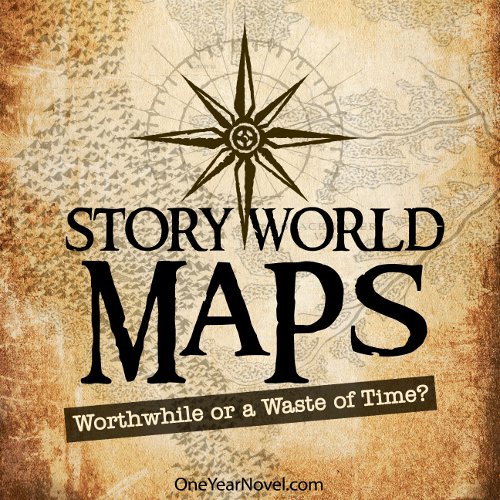 Shadow Writing, Part 4
Shadow Writing, Part 4
Writing is work.
I know this sounds obvious to anyone who has written. But non-writers sometimes react to this idea with shades of disbelief. “How hard can it be? It’s just words. You should try teaching/pouring concrete/waiting tables!”
But writers know. Writing is work. Which means that sometimes it’s rewarding and enlightening and fulfilling. And other times we can’t stand the thought of facing our unfinished novel, can’t stand the thought of all those blank pages, can’t bring ourselves to sit for hours in front of a blinking cursor.
Everyone, in every line of work, has those days. And that’s okay. As writers, those are the days when we get other things done. The office gets cleaned, the oil in the car is finally changed, the sock drawer is arranged by color. Procrastination can be useful. Without it my dogs would never get a bath.
But eventually we must face the main task of being a writer, which is writing.
Unless you are lucky enough to find a diversion that helps you write without making you write.
Recently I stumbled across a non-writing activity that actually fueled my imagination. It made certain colorless sections of my work-in-progress come to life, which meant that I could do it without feeling guilty. (My sock drawer, no longer tidy, now throws silent accusations at me every morning.)
I started making maps.
My justification for mapmaking was the complexity of my novel, In the Shadow of the Wise. Of course I needed a map. How else would I know how long it took my characters to travel through the Gallian mountains on horseback? How else would I know where to place the Old Quarter of Serapis? Mapmaking wasn’t procrastination. It was my job!
Furthermore, I had read a quote from Tolkien that gave my world-building idea the barest tinge of credibility:
If you’re going to have a complicated story you must work to a map; otherwise you’ll never make a map of it afterwards.
See? Tolkien had suggested it. It must be a good idea.
Alert to this new danger of finishing a novel too soon (that is, without a map), I threw myself into the non-procrastinative labors of inventive cartography.
Imagine my surprise when I discovered that I really wasn’t just postponing my rough draft. The maps were actually helping me to visualize the world of Rhega, its cities and mountains and deserts—even its cultures.
It’s true that I’ve always used maps. For The Legends of Tira-Nor series I created a total of five maps covering three books. But this process spanned several years, and was undertaken as a necessity rather than as a bit of self-serving procrastination.
For Shadow I planned 13 maps, all drawn to relative scale. 9 of the 13 were completed in two weeks. I started with a map of the planet and worked inward: the southern half of Lorica (the continent on which most of the action takes place); the Blackwater Valley; the Seven Falls region; the city of Tyris; Gregor’s Abbey.
In mapmaking I re-discovered something I had learned as a child in public school and then forgotten. During boring lectures I sometimes drew worlds on graph paper; the maps I drew would suggest images and daydreams and stories.
I should have known from personal experience that a map is really a frame. If you give your imagination a suitable container, your mind will try to fill it. The movie-making engine of your imagination will look for connections and meaning. It will try to connect the dots, to make sense, to fill in the blanks. This is why car headlights can look like eyes, or a drain pipe can look like a mouth, or a cloud can look like an elephant.
If the setting of your work-in-progress is foggy and ethereal, try giving your imagination something to work with. Give it boundaries and definition. Give it a map.
You might discover a world coming to life.
Procrastination, like daydreaming, can occasionally be useful.
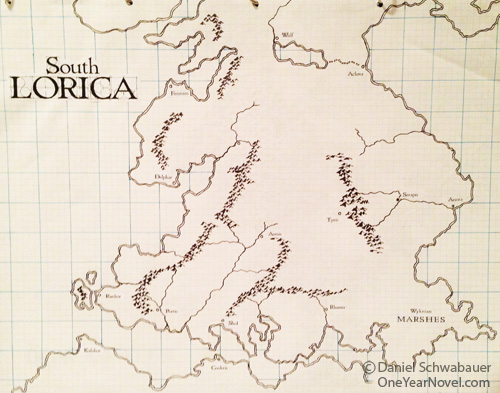
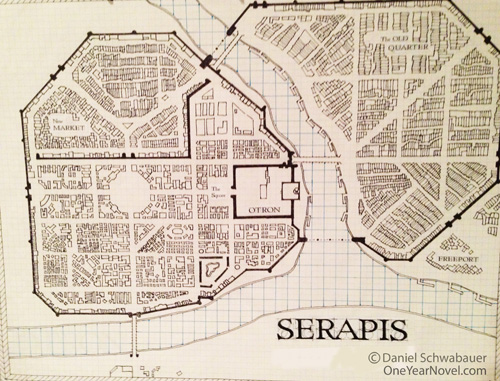
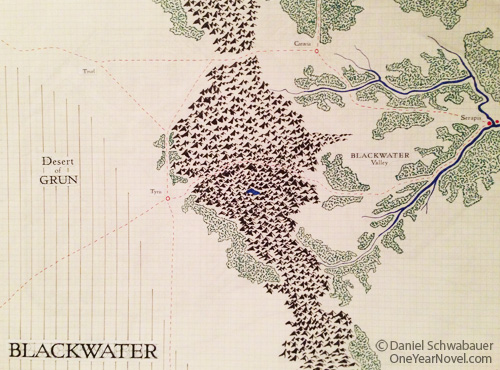


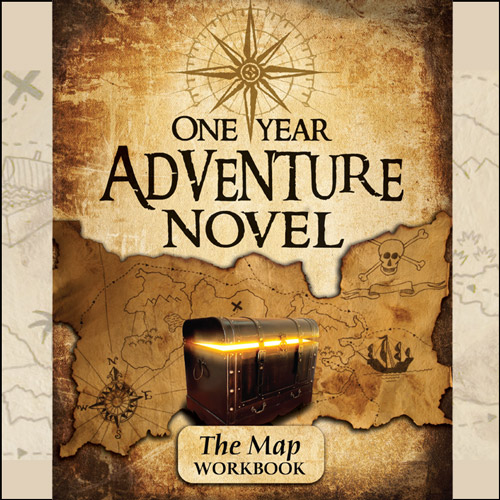
I absolutely love your maps, Mr. S. 😀 They’re beautiful.
Do you have any tips for someone who wants to make maps but doesn’t know how/has limited art skills?
Thanks for posting! 🙂
~hannah!♥
Those maps look really good! I like drawing maps and I have done that for my most recent story even though it only takes place in a really small area, but I found it really good to be able to see exactly where everything was, and I love maps anyway,
Ditto hannah.Your maps are fantastic.
For people who have no background in drawing and worry this means they can’t develop skills in it, may I recommend a 1957 book that helped me — and is happily back on the market after 30 years away? Henning Nelms’s “Thinking With a Pencil” teaches many drawing techniques from basic to advanced, for a wide variety of uses from cartooning to illustration to design to (as here) map-making, and especially as an aid to thinking clearly by organizing thoughts on paper. I was very lucky to discover this book early in high school, and I don’t want to think what the rest of my academic career would have been like otherwise. (So also give copies to your HS/college-bound kids!)
P.S. On Amazon, if you choose to use that vendor, the book is at:
http://www.amazon.com/Thinking-Pencil-Henning-Nelms/dp/1626541841
(No commission is linked, i.e. I won’t get a penny from your buying a copy.)